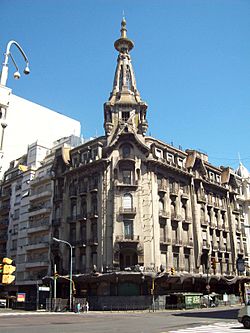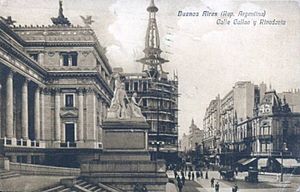Confitería del Molino facts for kids
Quick facts for kids Confitería del Molino |
|
|---|---|

View from the Congressional Plaza
|
|
| Alternative names | El Molino |
| General information | |
| Architectural style | Art Nouveau |
| Address | Av. Rivadavia 1815 |
| Town or city | Buenos Aires |
| Country | Argentina |
| Coordinates | 34°36′32″S 58°23′32″W / 34.60889°S 58.39222°W |
| Construction started | 1912 |
| Inaugurated | 1916 |
| Owner | Argentine National Congress |
| Technical details | |
| Floor count | 6 |
| Floor area | 5,450 m2 (58,700 sq ft) |
| Design and construction | |
| Architect | Francesco Gianotti |
| Main contractor | GEOPÉ |
The Confitería del Molino (which means "The Mill" in Spanish) is a famous old coffeehouse in Buenos Aires, Argentina. It has a special Art Nouveau style of architecture. You can find it right across from the National Congress building and the Congressional Plaza. It sits at the corner of Callao and Rivadavia avenues in the neighborhood of Balvanera.
The Confitería del Molino first opened its doors on July 9, 1916. It closed in 1997. In that same year, the Argentine Congress declared it a National Historic Monument. After closing, the building became quite run down. In 2014, a new law was passed to take over the coffeehouse and make sure it was restored. Work to fix it up began in 2016 and is still happening today.
History of El Molino
A well-known baker named Cayetano Brenna wanted a special building for his café. In 1915, he asked Italian architect Francisco Gianotti to design it. The café opened on July 9, 1916. When the building was finished in 1917, it was one of the tallest in Buenos Aires. It had a corner tower that reached 65 metres (213 ft) high.
The tower was lit up from the inside with electric lights. It also featured beautiful stained glass windows and decorative windmill sails. El Molino and another building called Galería Güemes are two of Gianotti's most important works. They are great examples of the Art Nouveau style in Buenos Aires.
Cayetano Brenna passed away in 1938. Renato Varesse then took over the business until 1950. After that, Antonio Armentano managed it, selling the business in 1978. The new owners faced financial problems, and the coffeehouse went bankrupt. Later, Brenna's grandchildren bought it back. They made many improvements to update it.
Over the years, El Molino became a popular spot for many important people. Artists, business leaders, and politicians often met there. The café closed on February 23, 1997. Since then, its owners did not take care of it, and the building slowly fell apart. It became clear that a lot of work was needed to save it.
The Confitería del Molino was named a National Historic Monument in 1997. On November 12, 2014, Congress agreed to buy it for the Argentine Government. Everyone in Congress voted yes. The plans include fixing up the building and reopening the famous café. There will also be a museum about life in Buenos Aires in the early 1900s. The building will officially be an extra part of the Argentine Congress. It will be used for many things and managed by a special group from Congress. However, the coffee shop itself will be run by a private company.
Famous Visitors
Many famous people visited Confitería del Molino over the years. It was a favorite meeting place for important figures in culture, business, and politics.
- Alfredo Palacios
- Tito Schipa
- Beniamino Gigli
- Lily Pons
- Leopoldo Lugones
- Amado Nervo
- José Ingenieros
- Oliverio Girondo
- Roberto Arlt
- Ramón Gómez de la Serna
- Lisandro de la Torre
- Eva Perón
- Niní Marshall
- Libertad Lamarque
- Madonna
- Carlos Gardel
- Adolfo Bioy Casares
- Isser Harel
- Rafi Eitan
In Popular Culture
The Confitería del Molino has appeared in movies and music videos:
- In 1996, the American singer Madonna filmed the music video for her song Love Don't Live Here Anymore in the main hall of the coffeehouse.
- The 1996 movie Autumn Sun also had scenes filmed at this location.
Views
See also
 In Spanish: Confitería del Molino para niños
In Spanish: Confitería del Molino para niños







